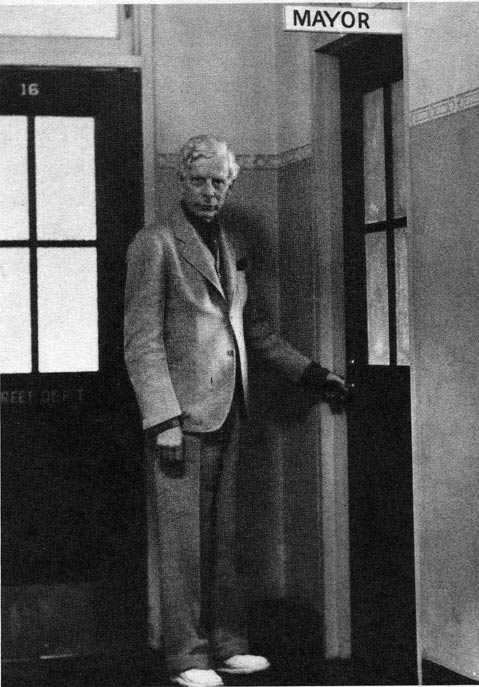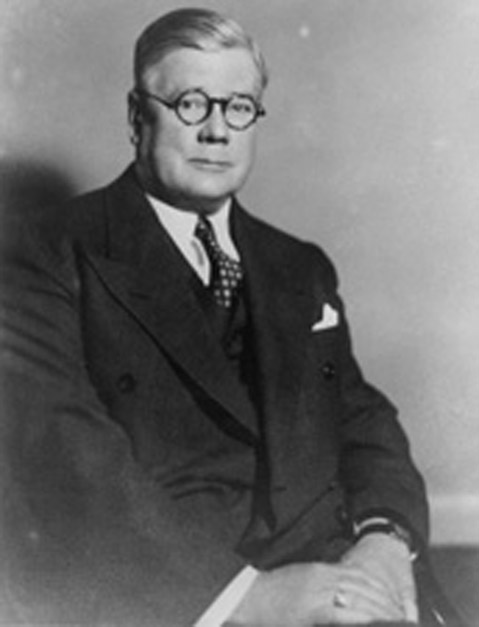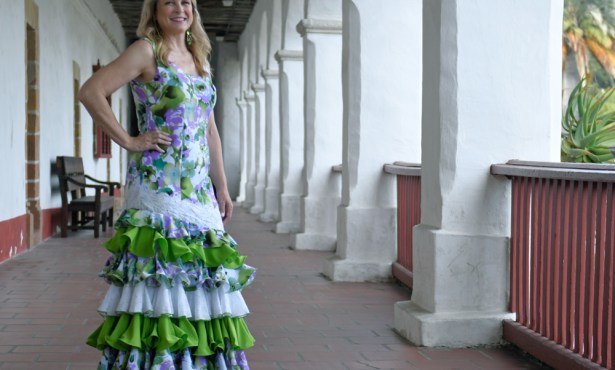S.B.’s Madcap Mayor
The Rise and Fall of E.O. Hansen
To the extent Santa Barbara’s former mayor Edmund Oscar Hanson is remembered at all, it’s usually as a collective brain fart in the whirlwind of Santa Barbara’s long-forgotten past. That’s too bad. Even now, Hanson — who reigned supreme from 1935 to 1936 — poses too many nagging questions for which there aren’t clear-enough answers. Santa Barbara historians have been content to tag Hanson as a crank, a crackpot, and our very own “dictator.” And undeniably, he was all three. After all, Hanson effectively declared a state of siege just five minutes after being sworn in, dispatching in the dead of night a team of cops to City Hall to prevent duly appointed department heads from entering their offices the next morning. Only moments before, Hanson had fired the chief of police and appointed in his stead a mere rookie patrol officer who would do his bidding.

From there, it only got wilder. Hanson, a retired soap company owner from the Midwest, seemed to actively seek out conflict. He infamously got in a late-night street brawl with a Montecito chauffeur after the two visited a mixed-race night club on Haley Street together. The chauffeur made a disrespectful remark about the red-headed woman — not Hanson’s wife — then keeping the mayor company. (Hanson claimed that it didn’t happen and he was never there.) He was arrested for assault with a deadly weapon after the city’s license inspector claimed Hanson yanked a gun from his Fiesta cummerbund and pointed it at him. (Hanson claimed it was a pipe, not a gun.) Eventually, an out-of-town judge would dismiss the charge for lack of reliable evidence. Hanson was written up for attending a Fiesta party — reportedly hosted by the Jaycees — featuring at least one nude female dancer. (Hanson claimed it was a setup and insisted he moved to the other side of the room the moment the woman dropped her shawl.)
When others weren’t writing about him, Hanson produced endless streams of copy about himself. He referred to himself either as “Hanson” or “The Mayor,” never as “I.” To describe his style as florid understates the case considerably. In describing councilmember Eugene M. Harris — with whom he constantly feuded — Hanson wrote, “The Mayor laughs at Eugene Harris, who has hated the Mayor because the Mayor refuses to recognize the small mind of Harris, which rattles as would a pea in a large pan.”
What makes Hanson revealing — and not merely entertaining — are the times in which he ran and who he chose to run — and rail — against. Hanson jumped into Santa Barbara politics at the height of the Depression. It’s true Santa Barbara fared better than most places, but even so, many families faced crushing economic hardships. A retired businessman who owned one of the largest, most expensive tracts of waterfront property in town, Hanson made an unlikely populist and champion of the working man. But he was emphatically both. He’d clean out City Hall and create thousands of jobs. He’d stop cops from writing parking tickets and fire them if they were rude. He’d impose a moratorium on overdue water charges and water would be delivered — free of charge — to homes not hooked up. Smoking would be banned in City Hall, and council meetings would be moved to night so people could attend. Loud speakers would be installed so that people in De la Guerra Plaza could listen to council meetings. He’d build tennis courts, outdoor swimming pools, and baseball diamonds; people lucky enough to own yachts, he argued, could fend for themselves. He railed against chains stores and bought locally. An anti-tax skinflint, he ranted against bloated bureaucracies. But he also supported paying city workers a union scale.

Then — as it had been and would be — Santa Barbara was News-Press owner T.M. Storke’s town. It would be decades before Storke worked his considerable political mojo to create Lake Cachuma — still a crucial water source for the entire South Coast — or twist enough arms to get a University of California campus located in Goleta. But in 1935, Storke was already a statewide power broker to reckon with, having helped secure the Democratic Party’s presidential nomination for Franklin Delano Roosevelt in 1932. Nor did it hurt that Storke was close friends — and real estate partners — with U.S. senator William Gibbs McAdoo, who then had a home and wife (former President Woodrow Wilson’s daughter) in Santa Barbara.
Initially Storke and his editors dismissed Hanson as misguided but well-intentioned. But when they saw Hanson gaining traction, they quickly labeled him a stalking horse for Santa Barbara’s “underworld,” a reckless and dangerous experimentalist who found favor with “the ragtag and bobtail set” not to mention the “mental dyspeptics.” Hanson returned the favor. He turned Storke himself into a campaign issue, crusading loudly against T.M’s “bossism,” his media monopoly, and his behind-the-scenes intercessions just a few years before when high-ranking cops got caught paying bribes to the madam of a downtown bordello. When Hanson later started a weekly paper of his own — the Bugle — he devoted most of the ink to attacking “the Storke,” — as he called the newspaper publisher. If the Bugle wasn’t exposing embarrassing tax breaks the city assessor afforded the News-Press owner, then it was writing about bare-footed street urchins selling Storke’s papers early in the morning while standing on the wet sidewalks. Or how the streets in McAdoo’s neighborhood got preferential treatment when it came to maintenance.
Initially, Hanson got the better in the exchanges with Storke. He came in first out of a field of seven mayoral candidates, taking close to 50 percent of the vote. At the time, that was the highest turnout in city history. At the first council meeting over which Hanson presided, 1,600 people showed up, jamming the council chambers and crowding De la Guerra Plaza. A year later, Hanson’s critics would mount a recall campaign against him. They’d lose by 1,000 votes. Hanson, however, used the opportunity to launch a recall campaign of his own, targeting five of the councilmembers he deemed most hostile. He replaced four. Only Gene Harris — whom Hanson regularly mocked for being from Lompoc — would survive.
Edmund Oscar Hanson may have been a political whack job. But he was a political whack job with a lot of supporters.
Buoyed by such success, Hanson deluded himself into believing he wielded far more power than he legally did. When, for example, Hanson tried to fire all department heads but four — as he vowed to do during his campaign — his fellow councilmembers objected. They had some say in the matter, they insisted. And so, too, did members of the city’s many boards and commissions. When Hanson refused to budge — with great megalomaniacal melodrama — the council drafted new rules that clearly limited the mayor’s authority; he could now hire and fire his own secretary, the City Hall janitor, the assistant janitor, and the telephone operator.
What makes the Hanson saga genuinely disturbing — as opposed to merely captivating — is the manner with which he was eventually exiled from public life, five full months before his term of office expired. What the powers-that-be could not achieve at the ballot box, they accomplished in the courtroom. But they did so at great violence to the First Amendment. And this inconvenient reality is glossed over in most historical accounts as a matter of little consequence.
In November, Frank Stanley Selover — the editor of the Bugle — published two articles, scathingly critical of the way juries were then impaneled in Santa Barbara. Selover noted that there was a small cadre of “professional” jurors, typically older white men, who in the course of a year could render verdicts on many cases. He found 12 who’d served on more than six trials in the previous year. One served on 11, one on 10, and another one sat on nine. Relations between prosecutors, jurors, and judges could not help but be too cozy for comfort, he argued, under this system. And, of course, he was absolutely right. But he went even further. Selover — who once worked as a reporter for Storke as did his father — went even further. He also charged that attorneys on good terms with Judge Atwell Westwick or Sheriff James Ross could get whatever result they wanted thanks to the role played by these professional jurors. In his articles, Selover never provided any examples demonstrating this to be the case. But he didn’t try to, either. He merely asserted it.
By today’s standards, this would constitute slipshod journalism. But in October 1936, it was the stuff of criminal contempt-of-court proceedings against both Hanson and Selover. Judge Westwick and Sheriff Ross filed criminal complaints, charging that the articles defamed the delivery of justice in Santa Barbara County and held the courts up to contempt and distrust. Two charges were sworn out against Selover, one for each article. An additional charge was included against Hanson for speaking disparagingly of “the courthouse crowd” when asked by a reporter about a recent verdict in which Westwick had ordered a police officer Hanson had fired be rehired.
Strikingly, neither Hanson nor Selover asserted their right to freedom of speech. Instead, Selover’s attorney argued that since no specific cases were ever mentioned in Selover’s articles, California’s contempt laws could not be brought to bear. And Hanson sought only to toss Selover under the wheels of the nearest oncoming bus. Although the evidence clearly demonstrated the Bugle was published for, about, and by Hanson, the mayor claimed he had no investment in the paper, and he testified — very unconvincingly — he wasn’t quite sure he had a subscription. It would turn out that city employees were expected to subscribe to the Bugle, and if they didn’t, Hanson told one witness, they “might wake up one day without a job.” A few city employees testified they solicited subscriptions while on the City Hall dime; another who collected the money testified he kept it in his City Hall safe. And even a few cops were dispatched from time to time to make sure the kids delivering the paper weren’t chucking them in Mission Creek. It was not a pretty picture.
During his tenure in office, Hanson frequently boasted how much he relished confrontation. “In fact, I like having charges against me,” he once said. “As it allows me to hit as I wish, knowing I will hit any enemy to my plans.” But when confronted with three criminal counts — each carrying a penalty of five days in jail plus a $500 fine — Hanson, then 61, folded up tent. On October 10, he agreed to resign. (Coincidentally, that was the same day King Edward VIII of England announced he was abdicating his claim to the British throne so he could marry an American.) In exchange, the judge agreed to suspend the fines against Hanson and Selover. Hanson would complain that the job had placed a financial burden on him and his family. He’d been paid $6,000 during his 18 months on the job, but wound up spending nearly $12,000. To help Hanson out of town, T.M. Storke’s good friend and philanthropist Dwight Murphy made a undisclosed donation to the Hanson family.
That, however, would not be the end of E.O. Hanson. In 1939, he was back in the spotlight, running for mayor again. Despite his flamboyant flameout of 1936, he did amazingly well, garnering 5,246 votes, more than when he first ran. His opponent, Patrick Maher, however, did even better, winning with 6,580. Hanson died in Long Beach in 1946. What became of his wife and daughter remains unknown.



